Labour Law E-Book: Labour Law Fundamentals, Employment Contracts, ILO
VerifiedAdded on 2023/01/23
|44
|10219
|90
Homework Assignment
AI Summary
This document provides an e-book on Labour Law, covering key concepts such as the origins of the International Labour Organization (ILO), its setup, the adoption and enforcement of international labour standards, and the uses of these standards in domestic spheres, particularly in the context of Sri Lanka. It also delves into the constitutional protection of labour rights in Sri Lanka. Furthermore, the e-book explores the contract of employment, including its aims and objectives, the historical context of employer-employee relations, the relevance of common law, and the distinction between servants and independent contractors. It analyzes the tests used to determine the existence of an employer-employee relationship, with a focus on the control test and relevant case laws. The document serves as a comprehensive introduction to labour law principles and their practical application.
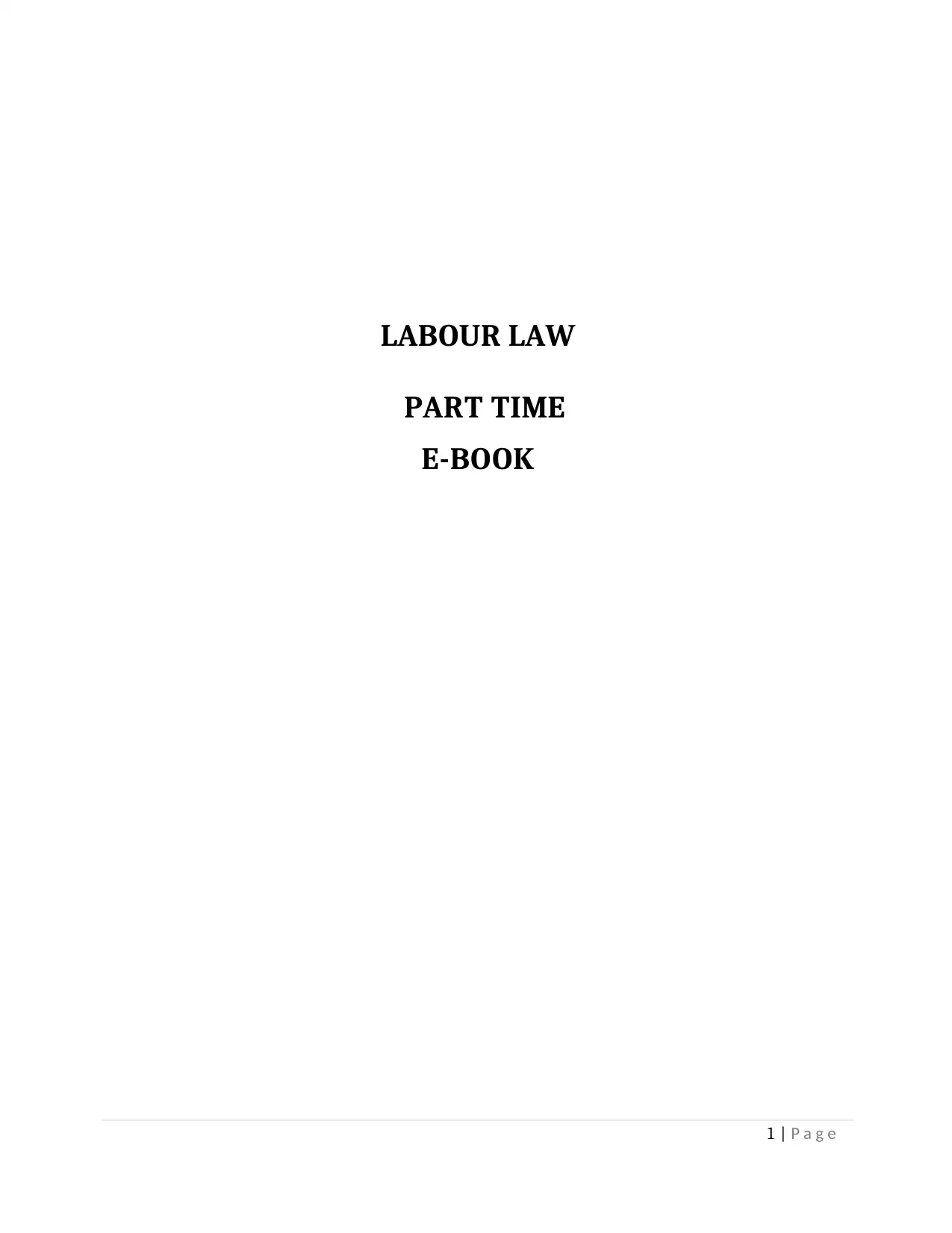
1 | P a g e
LABOUR LAW
PART TIME
E-BOOK
LABOUR LAW
PART TIME
E-BOOK
Paraphrase This Document
Need a fresh take? Get an instant paraphrase of this document with our AI Paraphraser

2 | P a g e
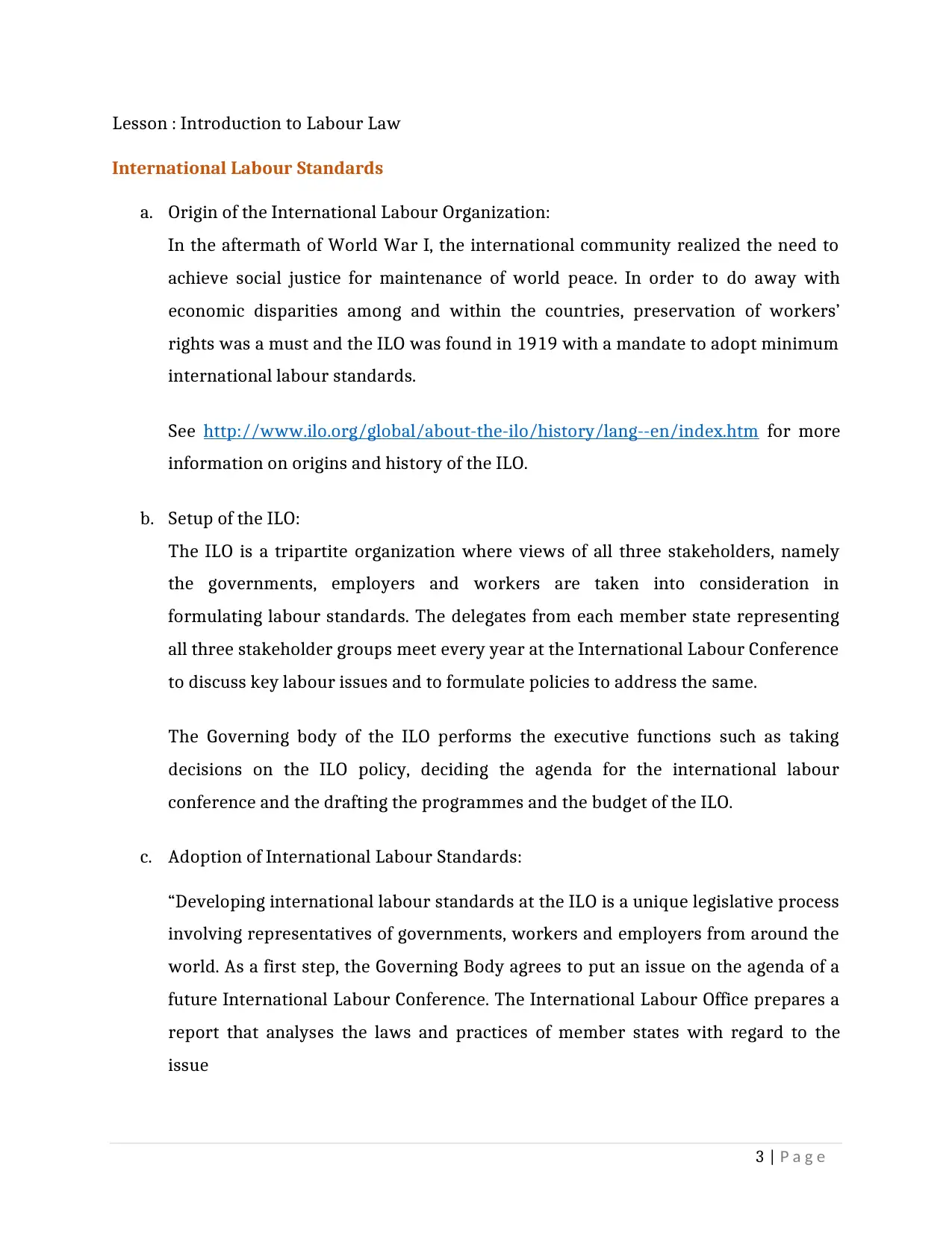
3 | P a g e
Lesson : Introduction to Labour Law
International Labour Standards
a. Origin of the International Labour Organization:
In the aftermath of World War I, the international community realized the need to
achieve social justice for maintenance of world peace. In order to do away with
economic disparities among and within the countries, preservation of workers’
rights was a must and the ILO was found in 1919 with a mandate to adopt minimum
international labour standards.
See http://www.ilo.org/global/about-the-ilo/history/lang--en/index.htm for more
information on origins and history of the ILO.
b. Setup of the ILO:
The ILO is a tripartite organization where views of all three stakeholders, namely
the governments, employers and workers are taken into consideration in
formulating labour standards. The delegates from each member state representing
all three stakeholder groups meet every year at the International Labour Conference
to discuss key labour issues and to formulate policies to address the same.
The Governing body of the ILO performs the executive functions such as taking
decisions on the ILO policy, deciding the agenda for the international labour
conference and the drafting the programmes and the budget of the ILO.
c. Adoption of International Labour Standards:
“Developing international labour standards at the ILO is a unique legislative process
involving representatives of governments, workers and employers from around the
world. As a first step, the Governing Body agrees to put an issue on the agenda of a
future International Labour Conference. The International Labour Office prepares a
report that analyses the laws and practices of member states with regard to the
issue
Lesson : Introduction to Labour Law
International Labour Standards
a. Origin of the International Labour Organization:
In the aftermath of World War I, the international community realized the need to
achieve social justice for maintenance of world peace. In order to do away with
economic disparities among and within the countries, preservation of workers’
rights was a must and the ILO was found in 1919 with a mandate to adopt minimum
international labour standards.
See http://www.ilo.org/global/about-the-ilo/history/lang--en/index.htm for more
information on origins and history of the ILO.
b. Setup of the ILO:
The ILO is a tripartite organization where views of all three stakeholders, namely
the governments, employers and workers are taken into consideration in
formulating labour standards. The delegates from each member state representing
all three stakeholder groups meet every year at the International Labour Conference
to discuss key labour issues and to formulate policies to address the same.
The Governing body of the ILO performs the executive functions such as taking
decisions on the ILO policy, deciding the agenda for the international labour
conference and the drafting the programmes and the budget of the ILO.
c. Adoption of International Labour Standards:
“Developing international labour standards at the ILO is a unique legislative process
involving representatives of governments, workers and employers from around the
world. As a first step, the Governing Body agrees to put an issue on the agenda of a
future International Labour Conference. The International Labour Office prepares a
report that analyses the laws and practices of member states with regard to the
issue
⊘ This is a preview!⊘
Do you want full access?
Subscribe today to unlock all pages.

Trusted by 1+ million students worldwide
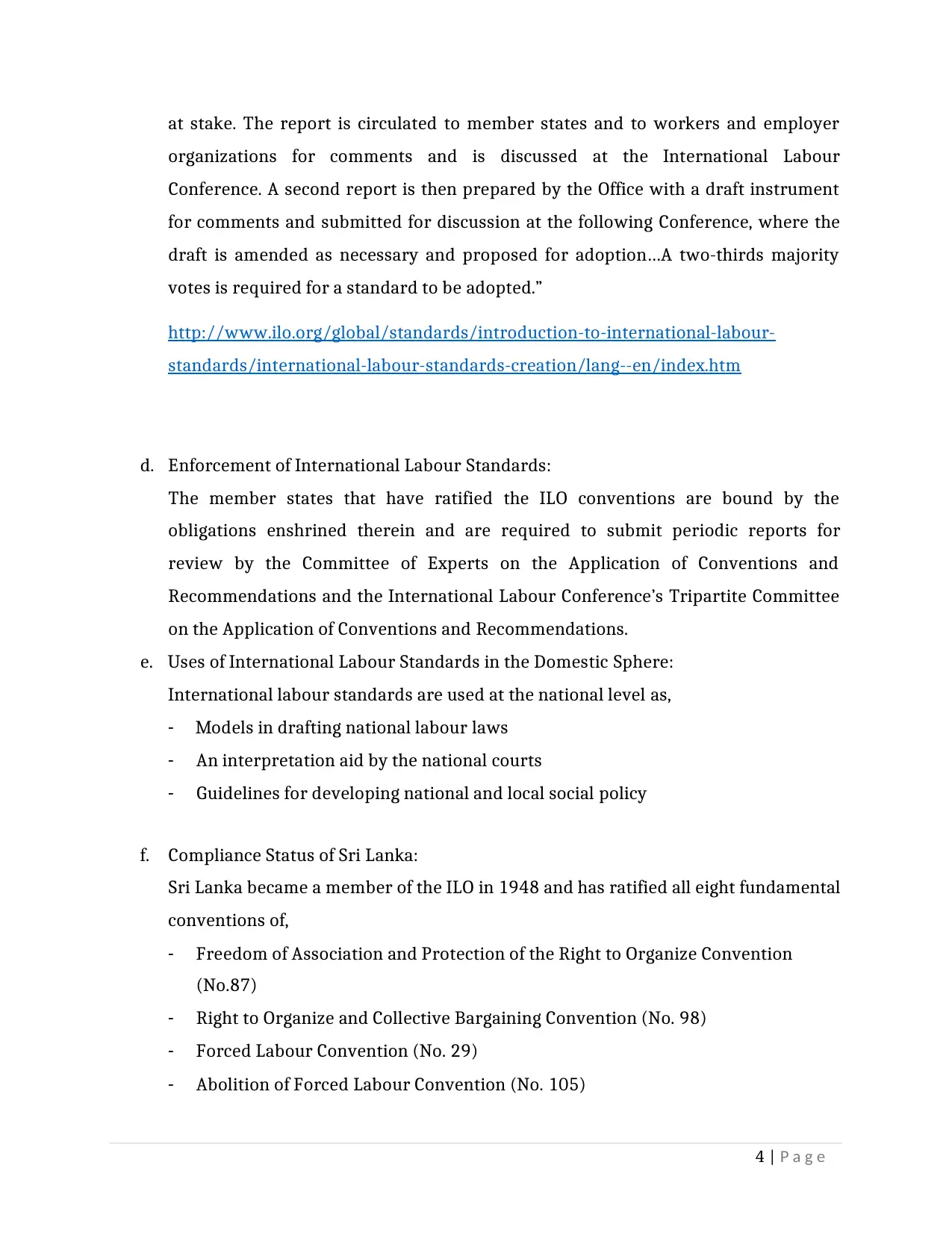
4 | P a g e
at stake. The report is circulated to member states and to workers and employer
organizations for comments and is discussed at the International Labour
Conference. A second report is then prepared by the Office with a draft instrument
for comments and submitted for discussion at the following Conference, where the
draft is amended as necessary and proposed for adoption…A two-thirds majority
votes is required for a standard to be adopted.”
http://www.ilo.org/global/standards/introduction-to-international-labour-
standards/international-labour-standards-creation/lang--en/index.htm
d. Enforcement of International Labour Standards:
The member states that have ratified the ILO conventions are bound by the
obligations enshrined therein and are required to submit periodic reports for
review by the Committee of Experts on the Application of Conventions and
Recommendations and the International Labour Conference’s Tripartite Committee
on the Application of Conventions and Recommendations.
e. Uses of International Labour Standards in the Domestic Sphere:
International labour standards are used at the national level as,
- Models in drafting national labour laws
- An interpretation aid by the national courts
- Guidelines for developing national and local social policy
f. Compliance Status of Sri Lanka:
Sri Lanka became a member of the ILO in 1948 and has ratified all eight fundamental
conventions of,
- Freedom of Association and Protection of the Right to Organize Convention
(No.87)
- Right to Organize and Collective Bargaining Convention (No. 98)
- Forced Labour Convention (No. 29)
- Abolition of Forced Labour Convention (No. 105)
at stake. The report is circulated to member states and to workers and employer
organizations for comments and is discussed at the International Labour
Conference. A second report is then prepared by the Office with a draft instrument
for comments and submitted for discussion at the following Conference, where the
draft is amended as necessary and proposed for adoption…A two-thirds majority
votes is required for a standard to be adopted.”
http://www.ilo.org/global/standards/introduction-to-international-labour-
standards/international-labour-standards-creation/lang--en/index.htm
d. Enforcement of International Labour Standards:
The member states that have ratified the ILO conventions are bound by the
obligations enshrined therein and are required to submit periodic reports for
review by the Committee of Experts on the Application of Conventions and
Recommendations and the International Labour Conference’s Tripartite Committee
on the Application of Conventions and Recommendations.
e. Uses of International Labour Standards in the Domestic Sphere:
International labour standards are used at the national level as,
- Models in drafting national labour laws
- An interpretation aid by the national courts
- Guidelines for developing national and local social policy
f. Compliance Status of Sri Lanka:
Sri Lanka became a member of the ILO in 1948 and has ratified all eight fundamental
conventions of,
- Freedom of Association and Protection of the Right to Organize Convention
(No.87)
- Right to Organize and Collective Bargaining Convention (No. 98)
- Forced Labour Convention (No. 29)
- Abolition of Forced Labour Convention (No. 105)
Paraphrase This Document
Need a fresh take? Get an instant paraphrase of this document with our AI Paraphraser
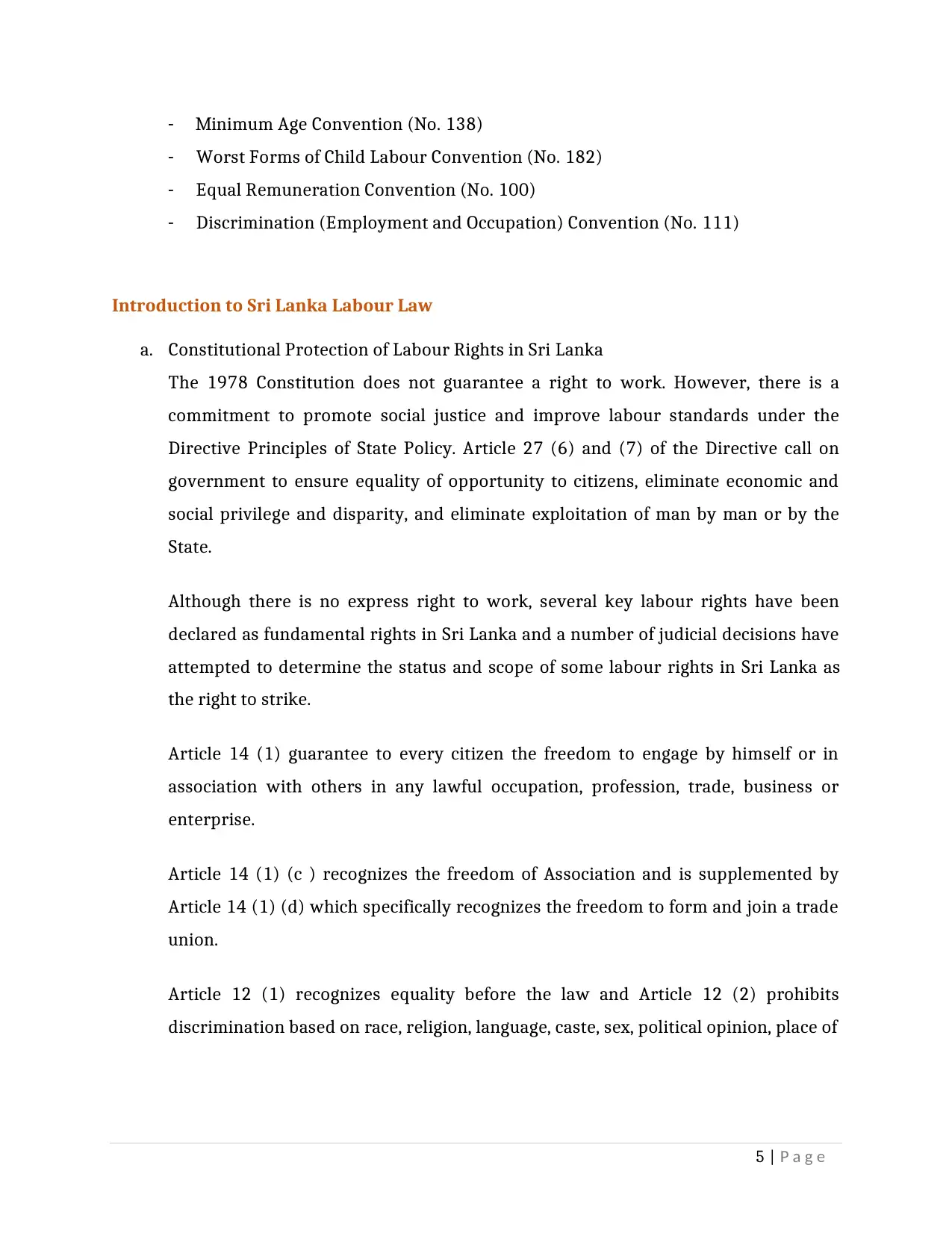
5 | P a g e
- Minimum Age Convention (No. 138)
- Worst Forms of Child Labour Convention (No. 182)
- Equal Remuneration Convention (No. 100)
- Discrimination (Employment and Occupation) Convention (No. 111)
Introduction to Sri Lanka Labour Law
a. Constitutional Protection of Labour Rights in Sri Lanka
The 1978 Constitution does not guarantee a right to work. However, there is a
commitment to promote social justice and improve labour standards under the
Directive Principles of State Policy. Article 27 (6) and (7) of the Directive call on
government to ensure equality of opportunity to citizens, eliminate economic and
social privilege and disparity, and eliminate exploitation of man by man or by the
State.
Although there is no express right to work, several key labour rights have been
declared as fundamental rights in Sri Lanka and a number of judicial decisions have
attempted to determine the status and scope of some labour rights in Sri Lanka as
the right to strike.
Article 14 (1) guarantee to every citizen the freedom to engage by himself or in
association with others in any lawful occupation, profession, trade, business or
enterprise.
Article 14 (1) (c ) recognizes the freedom of Association and is supplemented by
Article 14 (1) (d) which specifically recognizes the freedom to form and join a trade
union.
Article 12 (1) recognizes equality before the law and Article 12 (2) prohibits
discrimination based on race, religion, language, caste, sex, political opinion, place of
- Minimum Age Convention (No. 138)
- Worst Forms of Child Labour Convention (No. 182)
- Equal Remuneration Convention (No. 100)
- Discrimination (Employment and Occupation) Convention (No. 111)
Introduction to Sri Lanka Labour Law
a. Constitutional Protection of Labour Rights in Sri Lanka
The 1978 Constitution does not guarantee a right to work. However, there is a
commitment to promote social justice and improve labour standards under the
Directive Principles of State Policy. Article 27 (6) and (7) of the Directive call on
government to ensure equality of opportunity to citizens, eliminate economic and
social privilege and disparity, and eliminate exploitation of man by man or by the
State.
Although there is no express right to work, several key labour rights have been
declared as fundamental rights in Sri Lanka and a number of judicial decisions have
attempted to determine the status and scope of some labour rights in Sri Lanka as
the right to strike.
Article 14 (1) guarantee to every citizen the freedom to engage by himself or in
association with others in any lawful occupation, profession, trade, business or
enterprise.
Article 14 (1) (c ) recognizes the freedom of Association and is supplemented by
Article 14 (1) (d) which specifically recognizes the freedom to form and join a trade
union.
Article 12 (1) recognizes equality before the law and Article 12 (2) prohibits
discrimination based on race, religion, language, caste, sex, political opinion, place of

6 | P a g e
birth or any one of such grounds. The Constitutional guarantee of right to equality is
particularly important in relation to public sector employment and applies in all
stages of employment such as recruitment, promotion and termination.
birth or any one of such grounds. The Constitutional guarantee of right to equality is
particularly important in relation to public sector employment and applies in all
stages of employment such as recruitment, promotion and termination.
⊘ This is a preview!⊘
Do you want full access?
Subscribe today to unlock all pages.

Trusted by 1+ million students worldwide
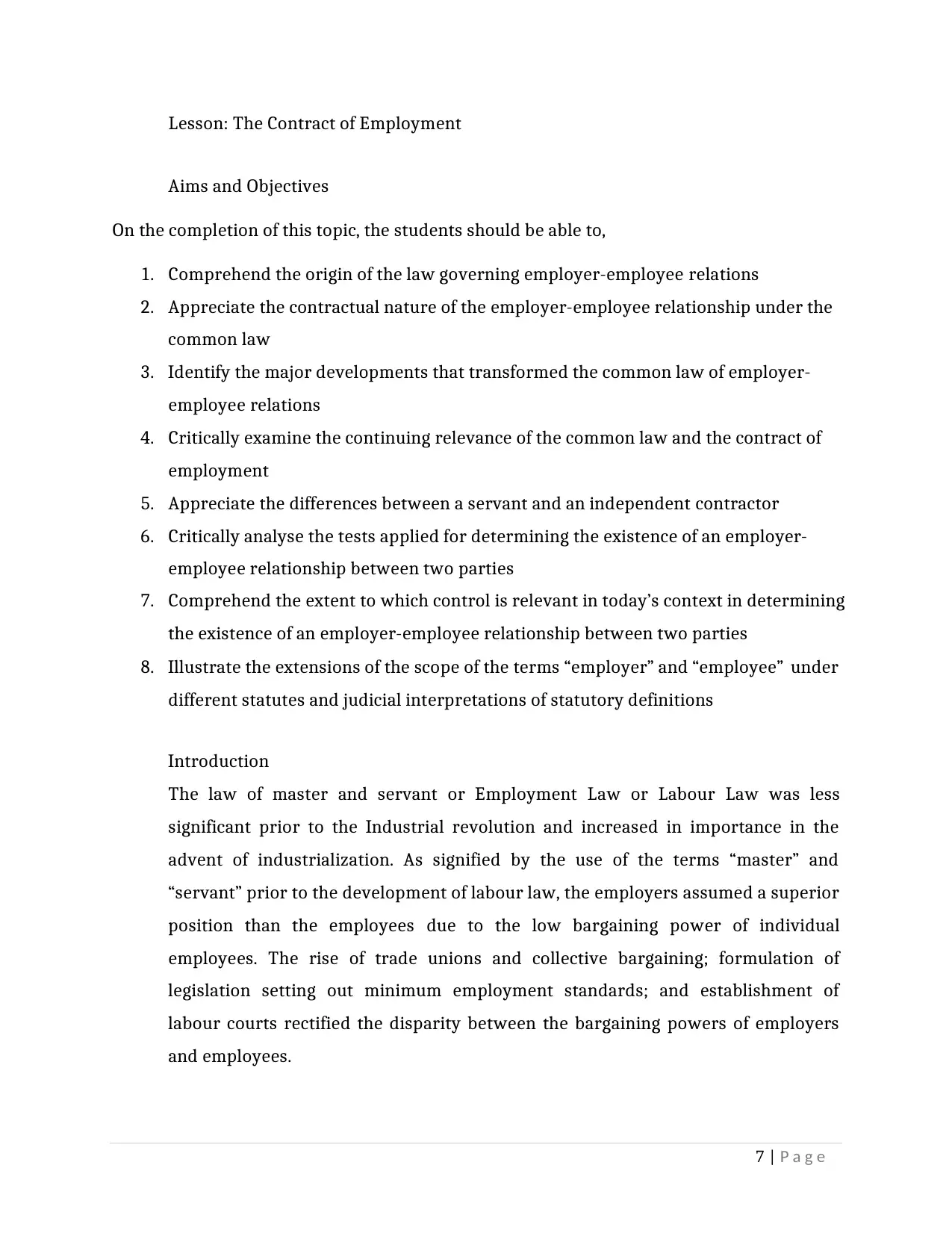
7 | P a g e
Lesson: The Contract of Employment
Aims and Objectives
On the completion of this topic, the students should be able to,
1. Comprehend the origin of the law governing employer-employee relations
2. Appreciate the contractual nature of the employer-employee relationship under the
common law
3. Identify the major developments that transformed the common law of employer-
employee relations
4. Critically examine the continuing relevance of the common law and the contract of
employment
5. Appreciate the differences between a servant and an independent contractor
6. Critically analyse the tests applied for determining the existence of an employer-
employee relationship between two parties
7. Comprehend the extent to which control is relevant in today’s context in determining
the existence of an employer-employee relationship between two parties
8. Illustrate the extensions of the scope of the terms “employer” and “employee” under
different statutes and judicial interpretations of statutory definitions
Introduction
The law of master and servant or Employment Law or Labour Law was less
significant prior to the Industrial revolution and increased in importance in the
advent of industrialization. As signified by the use of the terms “master” and
“servant” prior to the development of labour law, the employers assumed a superior
position than the employees due to the low bargaining power of individual
employees. The rise of trade unions and collective bargaining; formulation of
legislation setting out minimum employment standards; and establishment of
labour courts rectified the disparity between the bargaining powers of employers
and employees.
Lesson: The Contract of Employment
Aims and Objectives
On the completion of this topic, the students should be able to,
1. Comprehend the origin of the law governing employer-employee relations
2. Appreciate the contractual nature of the employer-employee relationship under the
common law
3. Identify the major developments that transformed the common law of employer-
employee relations
4. Critically examine the continuing relevance of the common law and the contract of
employment
5. Appreciate the differences between a servant and an independent contractor
6. Critically analyse the tests applied for determining the existence of an employer-
employee relationship between two parties
7. Comprehend the extent to which control is relevant in today’s context in determining
the existence of an employer-employee relationship between two parties
8. Illustrate the extensions of the scope of the terms “employer” and “employee” under
different statutes and judicial interpretations of statutory definitions
Introduction
The law of master and servant or Employment Law or Labour Law was less
significant prior to the Industrial revolution and increased in importance in the
advent of industrialization. As signified by the use of the terms “master” and
“servant” prior to the development of labour law, the employers assumed a superior
position than the employees due to the low bargaining power of individual
employees. The rise of trade unions and collective bargaining; formulation of
legislation setting out minimum employment standards; and establishment of
labour courts rectified the disparity between the bargaining powers of employers
and employees.
Paraphrase This Document
Need a fresh take? Get an instant paraphrase of this document with our AI Paraphraser
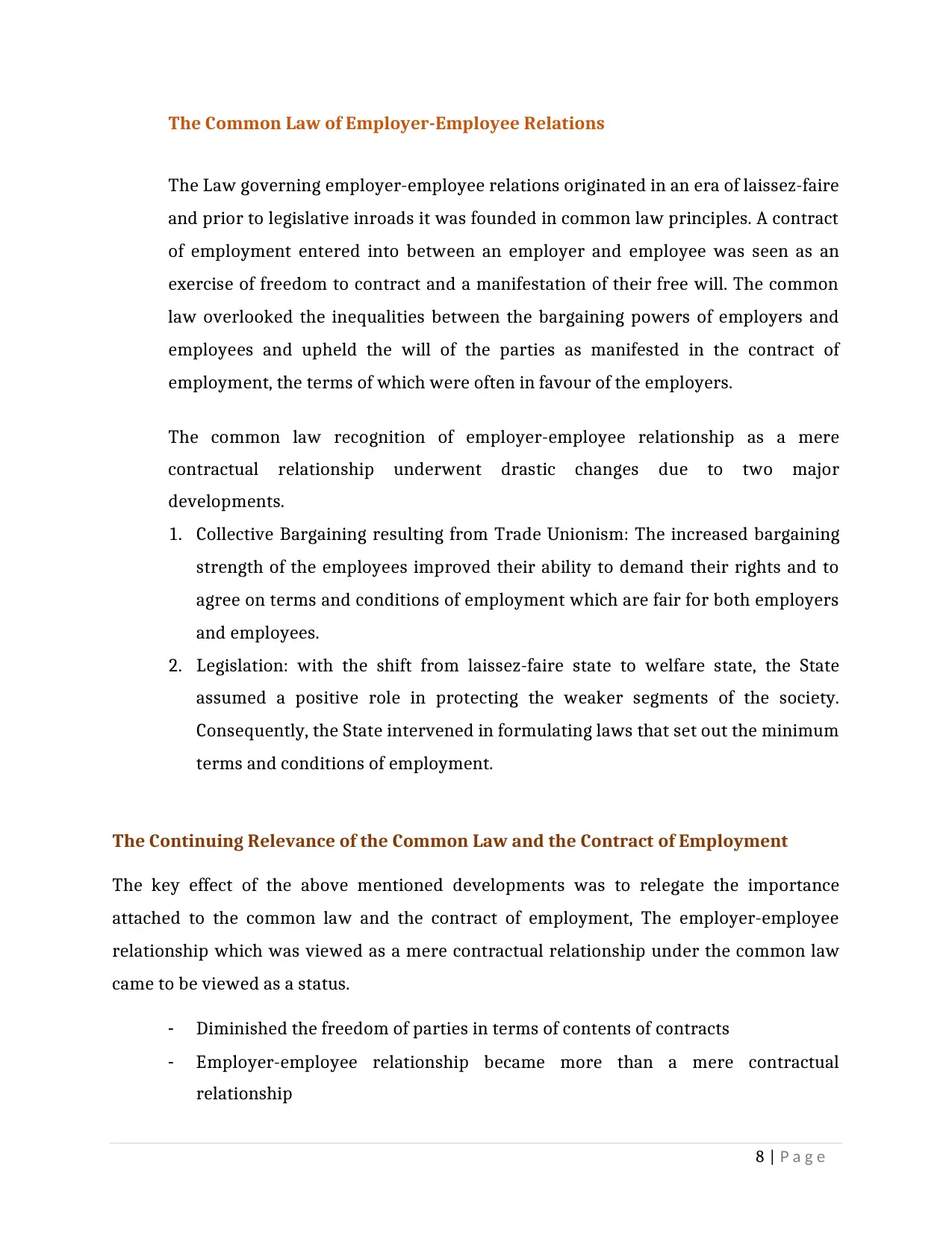
8 | P a g e
The Common Law of Employer-Employee Relations
The Law governing employer-employee relations originated in an era of laissez-faire
and prior to legislative inroads it was founded in common law principles. A contract
of employment entered into between an employer and employee was seen as an
exercise of freedom to contract and a manifestation of their free will. The common
law overlooked the inequalities between the bargaining powers of employers and
employees and upheld the will of the parties as manifested in the contract of
employment, the terms of which were often in favour of the employers.
The common law recognition of employer-employee relationship as a mere
contractual relationship underwent drastic changes due to two major
developments.
1. Collective Bargaining resulting from Trade Unionism: The increased bargaining
strength of the employees improved their ability to demand their rights and to
agree on terms and conditions of employment which are fair for both employers
and employees.
2. Legislation: with the shift from laissez-faire state to welfare state, the State
assumed a positive role in protecting the weaker segments of the society.
Consequently, the State intervened in formulating laws that set out the minimum
terms and conditions of employment.
The Continuing Relevance of the Common Law and the Contract of Employment
The key effect of the above mentioned developments was to relegate the importance
attached to the common law and the contract of employment, The employer-employee
relationship which was viewed as a mere contractual relationship under the common law
came to be viewed as a status.
- Diminished the freedom of parties in terms of contents of contracts
- Employer-employee relationship became more than a mere contractual
relationship
The Common Law of Employer-Employee Relations
The Law governing employer-employee relations originated in an era of laissez-faire
and prior to legislative inroads it was founded in common law principles. A contract
of employment entered into between an employer and employee was seen as an
exercise of freedom to contract and a manifestation of their free will. The common
law overlooked the inequalities between the bargaining powers of employers and
employees and upheld the will of the parties as manifested in the contract of
employment, the terms of which were often in favour of the employers.
The common law recognition of employer-employee relationship as a mere
contractual relationship underwent drastic changes due to two major
developments.
1. Collective Bargaining resulting from Trade Unionism: The increased bargaining
strength of the employees improved their ability to demand their rights and to
agree on terms and conditions of employment which are fair for both employers
and employees.
2. Legislation: with the shift from laissez-faire state to welfare state, the State
assumed a positive role in protecting the weaker segments of the society.
Consequently, the State intervened in formulating laws that set out the minimum
terms and conditions of employment.
The Continuing Relevance of the Common Law and the Contract of Employment
The key effect of the above mentioned developments was to relegate the importance
attached to the common law and the contract of employment, The employer-employee
relationship which was viewed as a mere contractual relationship under the common law
came to be viewed as a status.
- Diminished the freedom of parties in terms of contents of contracts
- Employer-employee relationship became more than a mere contractual
relationship
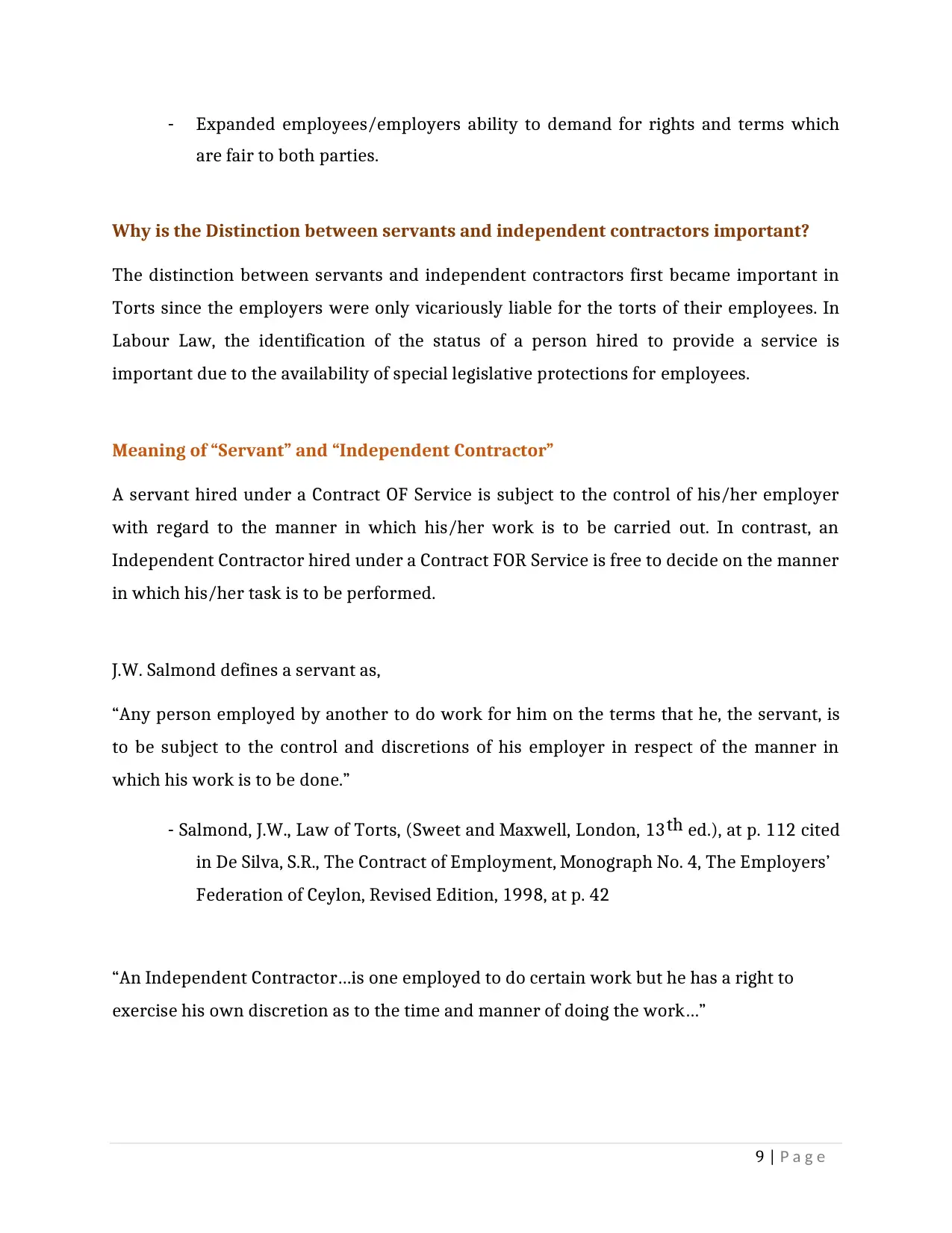
9 | P a g e
- Expanded employees/employers ability to demand for rights and terms which
are fair to both parties.
Why is the Distinction between servants and independent contractors important?
The distinction between servants and independent contractors first became important in
Torts since the employers were only vicariously liable for the torts of their employees. In
Labour Law, the identification of the status of a person hired to provide a service is
important due to the availability of special legislative protections for employees.
Meaning of “Servant” and “Independent Contractor”
A servant hired under a Contract OF Service is subject to the control of his/her employer
with regard to the manner in which his/her work is to be carried out. In contrast, an
Independent Contractor hired under a Contract FOR Service is free to decide on the manner
in which his/her task is to be performed.
J.W. Salmond defines a servant as,
“Any person employed by another to do work for him on the terms that he, the servant, is
to be subject to the control and discretions of his employer in respect of the manner in
which his work is to be done.”
- Salmond, J.W., Law of Torts, (Sweet and Maxwell, London, 13th ed.), at p. 112 cited
in De Silva, S.R., The Contract of Employment, Monograph No. 4, The Employers’
Federation of Ceylon, Revised Edition, 1998, at p. 42
“An Independent Contractor…is one employed to do certain work but he has a right to
exercise his own discretion as to the time and manner of doing the work…”
- Expanded employees/employers ability to demand for rights and terms which
are fair to both parties.
Why is the Distinction between servants and independent contractors important?
The distinction between servants and independent contractors first became important in
Torts since the employers were only vicariously liable for the torts of their employees. In
Labour Law, the identification of the status of a person hired to provide a service is
important due to the availability of special legislative protections for employees.
Meaning of “Servant” and “Independent Contractor”
A servant hired under a Contract OF Service is subject to the control of his/her employer
with regard to the manner in which his/her work is to be carried out. In contrast, an
Independent Contractor hired under a Contract FOR Service is free to decide on the manner
in which his/her task is to be performed.
J.W. Salmond defines a servant as,
“Any person employed by another to do work for him on the terms that he, the servant, is
to be subject to the control and discretions of his employer in respect of the manner in
which his work is to be done.”
- Salmond, J.W., Law of Torts, (Sweet and Maxwell, London, 13th ed.), at p. 112 cited
in De Silva, S.R., The Contract of Employment, Monograph No. 4, The Employers’
Federation of Ceylon, Revised Edition, 1998, at p. 42
“An Independent Contractor…is one employed to do certain work but he has a right to
exercise his own discretion as to the time and manner of doing the work…”
⊘ This is a preview!⊘
Do you want full access?
Subscribe today to unlock all pages.

Trusted by 1+ million students worldwide
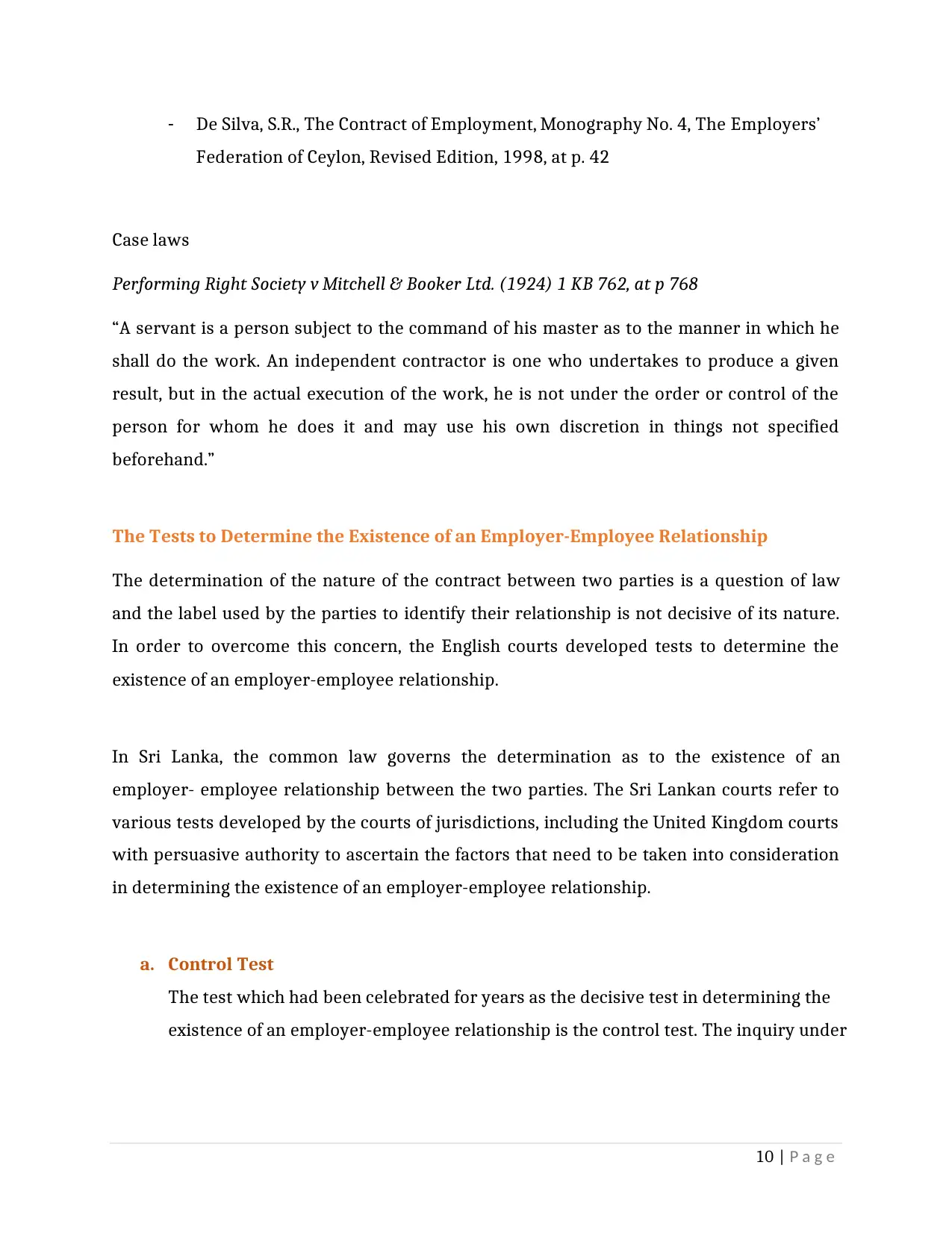
10 | P a g e
- De Silva, S.R., The Contract of Employment, Monography No. 4, The Employers’
Federation of Ceylon, Revised Edition, 1998, at p. 42
Case laws
Performing Right Society v Mitchell & Booker Ltd. (1924) 1 KB 762, at p 768
“A servant is a person subject to the command of his master as to the manner in which he
shall do the work. An independent contractor is one who undertakes to produce a given
result, but in the actual execution of the work, he is not under the order or control of the
person for whom he does it and may use his own discretion in things not specified
beforehand.”
The Tests to Determine the Existence of an Employer-Employee Relationship
The determination of the nature of the contract between two parties is a question of law
and the label used by the parties to identify their relationship is not decisive of its nature.
In order to overcome this concern, the English courts developed tests to determine the
existence of an employer-employee relationship.
In Sri Lanka, the common law governs the determination as to the existence of an
employer- employee relationship between the two parties. The Sri Lankan courts refer to
various tests developed by the courts of jurisdictions, including the United Kingdom courts
with persuasive authority to ascertain the factors that need to be taken into consideration
in determining the existence of an employer-employee relationship.
a. Control Test
The test which had been celebrated for years as the decisive test in determining the
existence of an employer-employee relationship is the control test. The inquiry under
- De Silva, S.R., The Contract of Employment, Monography No. 4, The Employers’
Federation of Ceylon, Revised Edition, 1998, at p. 42
Case laws
Performing Right Society v Mitchell & Booker Ltd. (1924) 1 KB 762, at p 768
“A servant is a person subject to the command of his master as to the manner in which he
shall do the work. An independent contractor is one who undertakes to produce a given
result, but in the actual execution of the work, he is not under the order or control of the
person for whom he does it and may use his own discretion in things not specified
beforehand.”
The Tests to Determine the Existence of an Employer-Employee Relationship
The determination of the nature of the contract between two parties is a question of law
and the label used by the parties to identify their relationship is not decisive of its nature.
In order to overcome this concern, the English courts developed tests to determine the
existence of an employer-employee relationship.
In Sri Lanka, the common law governs the determination as to the existence of an
employer- employee relationship between the two parties. The Sri Lankan courts refer to
various tests developed by the courts of jurisdictions, including the United Kingdom courts
with persuasive authority to ascertain the factors that need to be taken into consideration
in determining the existence of an employer-employee relationship.
a. Control Test
The test which had been celebrated for years as the decisive test in determining the
existence of an employer-employee relationship is the control test. The inquiry under
Paraphrase This Document
Need a fresh take? Get an instant paraphrase of this document with our AI Paraphraser
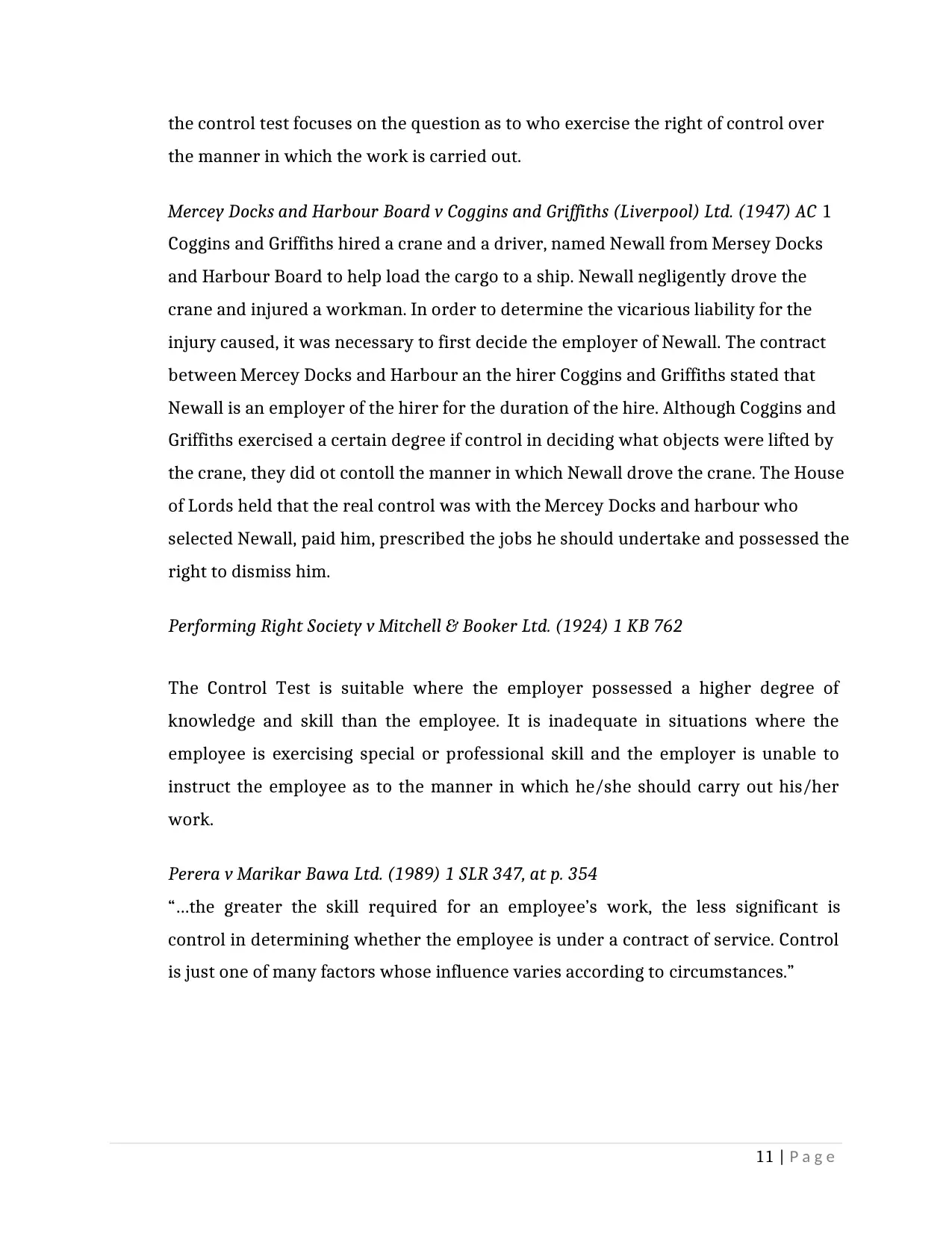
11 | P a g e
the control test focuses on the question as to who exercise the right of control over
the manner in which the work is carried out.
Mercey Docks and Harbour Board v Coggins and Griffiths (Liverpool) Ltd. (1947) AC 1
Coggins and Griffiths hired a crane and a driver, named Newall from Mersey Docks
and Harbour Board to help load the cargo to a ship. Newall negligently drove the
crane and injured a workman. In order to determine the vicarious liability for the
injury caused, it was necessary to first decide the employer of Newall. The contract
between Mercey Docks and Harbour an the hirer Coggins and Griffiths stated that
Newall is an employer of the hirer for the duration of the hire. Although Coggins and
Griffiths exercised a certain degree if control in deciding what objects were lifted by
the crane, they did ot contoll the manner in which Newall drove the crane. The House
of Lords held that the real control was with the Mercey Docks and harbour who
selected Newall, paid him, prescribed the jobs he should undertake and possessed the
right to dismiss him.
Performing Right Society v Mitchell & Booker Ltd. (1924) 1 KB 762
The Control Test is suitable where the employer possessed a higher degree of
knowledge and skill than the employee. It is inadequate in situations where the
employee is exercising special or professional skill and the employer is unable to
instruct the employee as to the manner in which he/she should carry out his/her
work.
Perera v Marikar Bawa Ltd. (1989) 1 SLR 347, at p. 354
“…the greater the skill required for an employee’s work, the less significant is
control in determining whether the employee is under a contract of service. Control
is just one of many factors whose influence varies according to circumstances.”
the control test focuses on the question as to who exercise the right of control over
the manner in which the work is carried out.
Mercey Docks and Harbour Board v Coggins and Griffiths (Liverpool) Ltd. (1947) AC 1
Coggins and Griffiths hired a crane and a driver, named Newall from Mersey Docks
and Harbour Board to help load the cargo to a ship. Newall negligently drove the
crane and injured a workman. In order to determine the vicarious liability for the
injury caused, it was necessary to first decide the employer of Newall. The contract
between Mercey Docks and Harbour an the hirer Coggins and Griffiths stated that
Newall is an employer of the hirer for the duration of the hire. Although Coggins and
Griffiths exercised a certain degree if control in deciding what objects were lifted by
the crane, they did ot contoll the manner in which Newall drove the crane. The House
of Lords held that the real control was with the Mercey Docks and harbour who
selected Newall, paid him, prescribed the jobs he should undertake and possessed the
right to dismiss him.
Performing Right Society v Mitchell & Booker Ltd. (1924) 1 KB 762
The Control Test is suitable where the employer possessed a higher degree of
knowledge and skill than the employee. It is inadequate in situations where the
employee is exercising special or professional skill and the employer is unable to
instruct the employee as to the manner in which he/she should carry out his/her
work.
Perera v Marikar Bawa Ltd. (1989) 1 SLR 347, at p. 354
“…the greater the skill required for an employee’s work, the less significant is
control in determining whether the employee is under a contract of service. Control
is just one of many factors whose influence varies according to circumstances.”
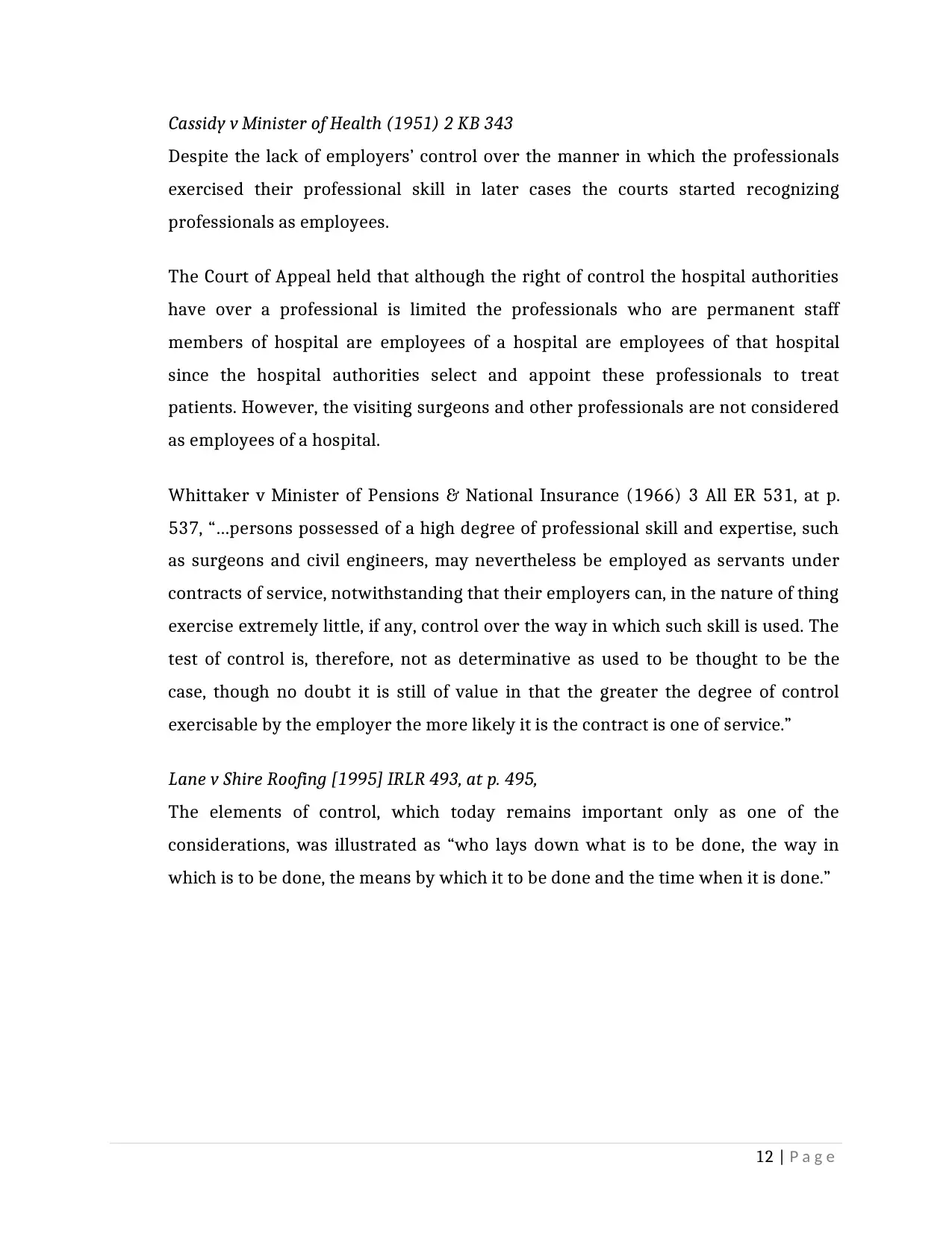
12 | P a g e
Cassidy v Minister of Health (1951) 2 KB 343
Despite the lack of employers’ control over the manner in which the professionals
exercised their professional skill in later cases the courts started recognizing
professionals as employees.
The Court of Appeal held that although the right of control the hospital authorities
have over a professional is limited the professionals who are permanent staff
members of hospital are employees of a hospital are employees of that hospital
since the hospital authorities select and appoint these professionals to treat
patients. However, the visiting surgeons and other professionals are not considered
as employees of a hospital.
Whittaker v Minister of Pensions & National Insurance (1966) 3 All ER 531, at p.
537, “…persons possessed of a high degree of professional skill and expertise, such
as surgeons and civil engineers, may nevertheless be employed as servants under
contracts of service, notwithstanding that their employers can, in the nature of thing
exercise extremely little, if any, control over the way in which such skill is used. The
test of control is, therefore, not as determinative as used to be thought to be the
case, though no doubt it is still of value in that the greater the degree of control
exercisable by the employer the more likely it is the contract is one of service.”
Lane v Shire Roofing [1995] IRLR 493, at p. 495,
The elements of control, which today remains important only as one of the
considerations, was illustrated as “who lays down what is to be done, the way in
which is to be done, the means by which it to be done and the time when it is done.”
Cassidy v Minister of Health (1951) 2 KB 343
Despite the lack of employers’ control over the manner in which the professionals
exercised their professional skill in later cases the courts started recognizing
professionals as employees.
The Court of Appeal held that although the right of control the hospital authorities
have over a professional is limited the professionals who are permanent staff
members of hospital are employees of a hospital are employees of that hospital
since the hospital authorities select and appoint these professionals to treat
patients. However, the visiting surgeons and other professionals are not considered
as employees of a hospital.
Whittaker v Minister of Pensions & National Insurance (1966) 3 All ER 531, at p.
537, “…persons possessed of a high degree of professional skill and expertise, such
as surgeons and civil engineers, may nevertheless be employed as servants under
contracts of service, notwithstanding that their employers can, in the nature of thing
exercise extremely little, if any, control over the way in which such skill is used. The
test of control is, therefore, not as determinative as used to be thought to be the
case, though no doubt it is still of value in that the greater the degree of control
exercisable by the employer the more likely it is the contract is one of service.”
Lane v Shire Roofing [1995] IRLR 493, at p. 495,
The elements of control, which today remains important only as one of the
considerations, was illustrated as “who lays down what is to be done, the way in
which is to be done, the means by which it to be done and the time when it is done.”
⊘ This is a preview!⊘
Do you want full access?
Subscribe today to unlock all pages.

Trusted by 1+ million students worldwide
1 out of 44
Related Documents
Your All-in-One AI-Powered Toolkit for Academic Success.
+13062052269
info@desklib.com
Available 24*7 on WhatsApp / Email
![[object Object]](/_next/static/media/star-bottom.7253800d.svg)
Unlock your academic potential
Copyright © 2020–2025 A2Z Services. All Rights Reserved. Developed and managed by ZUCOL.





